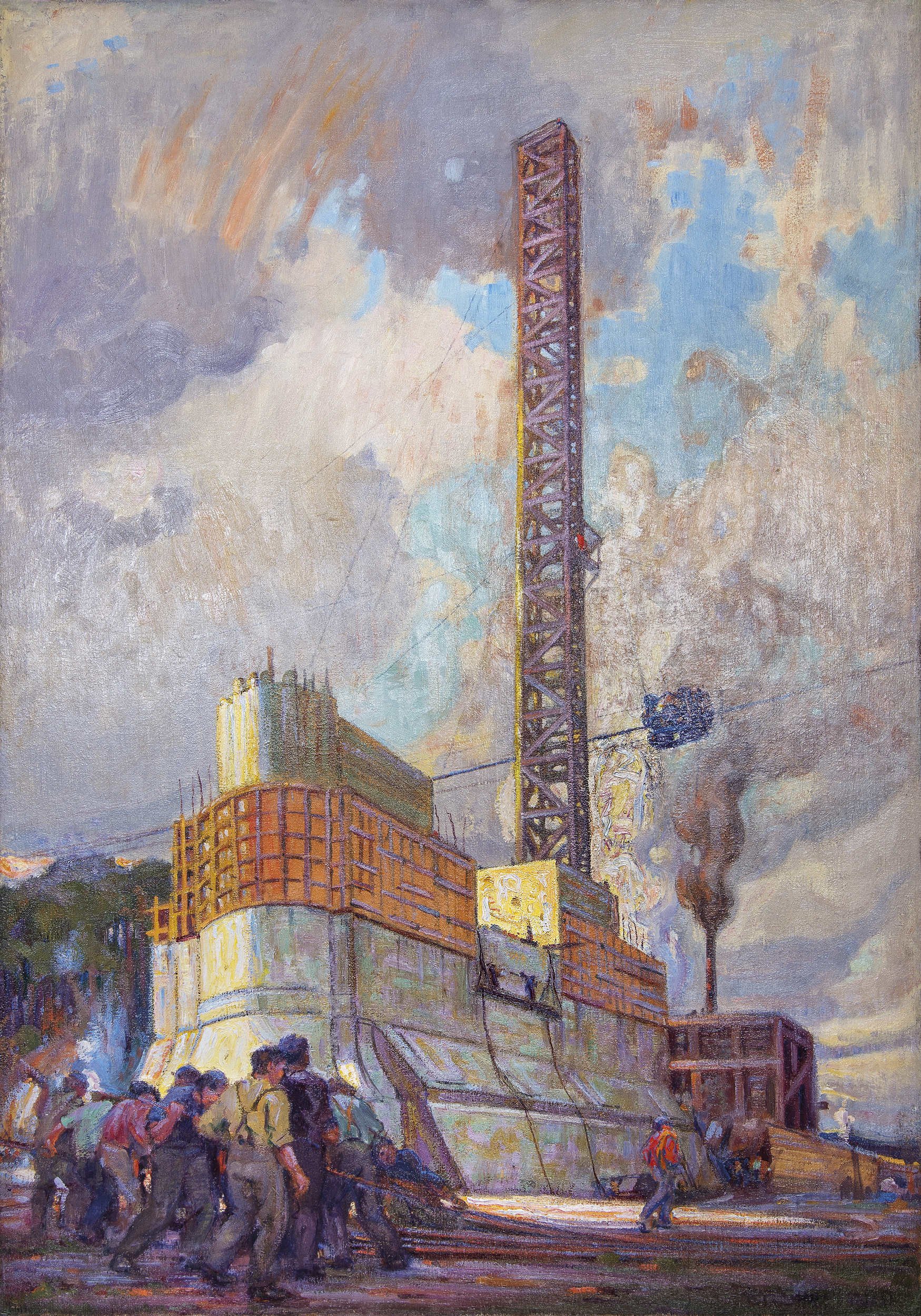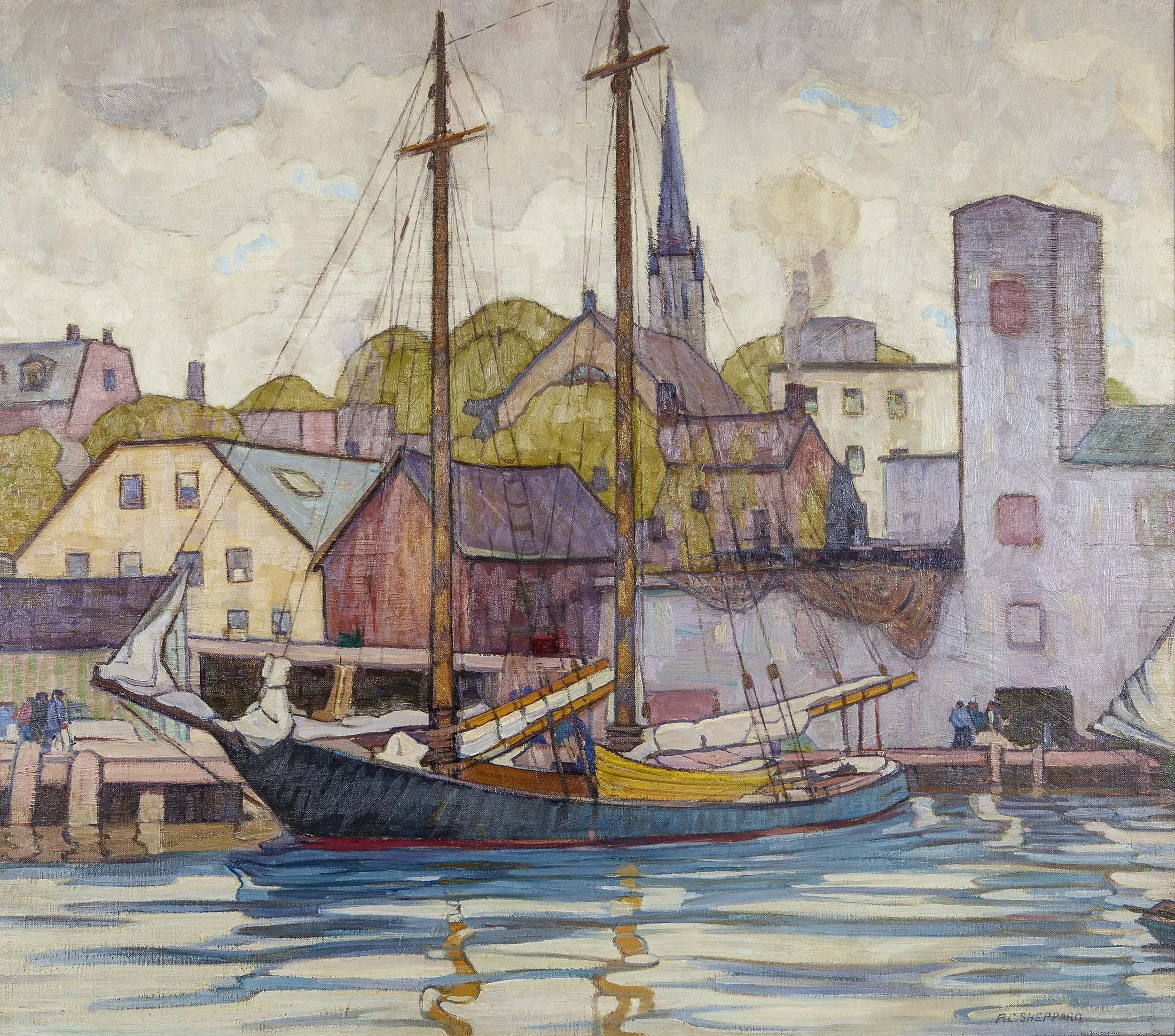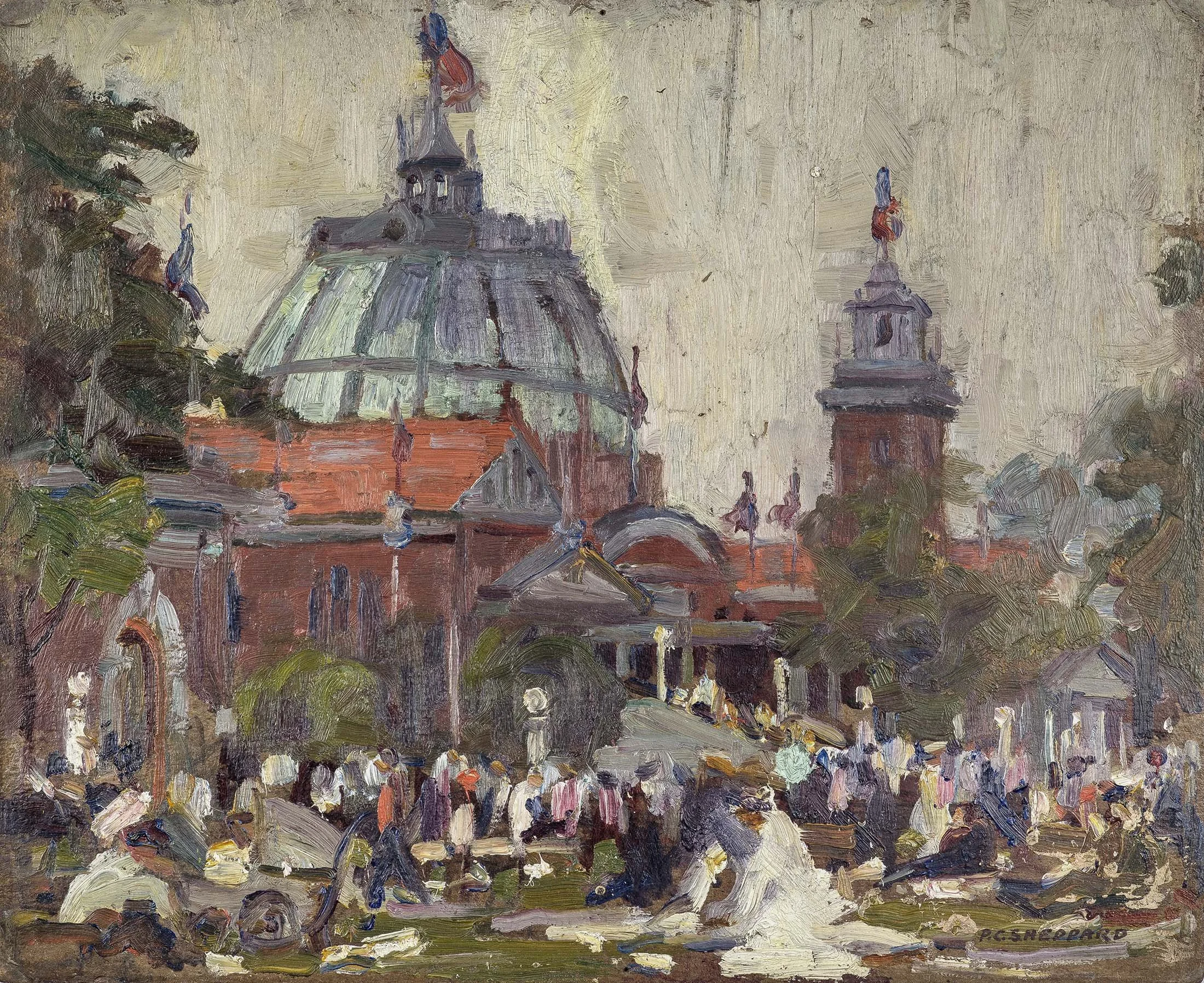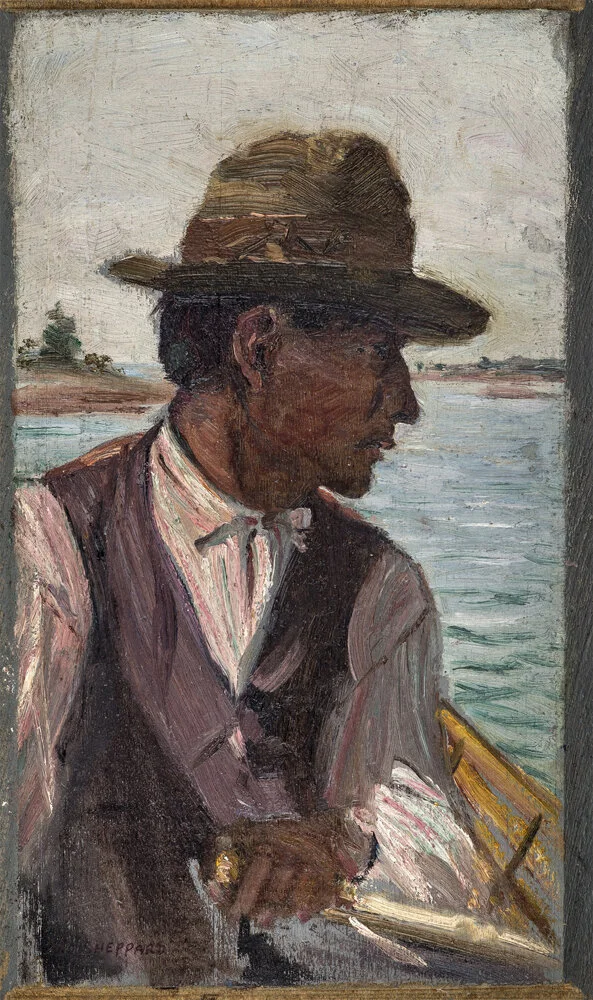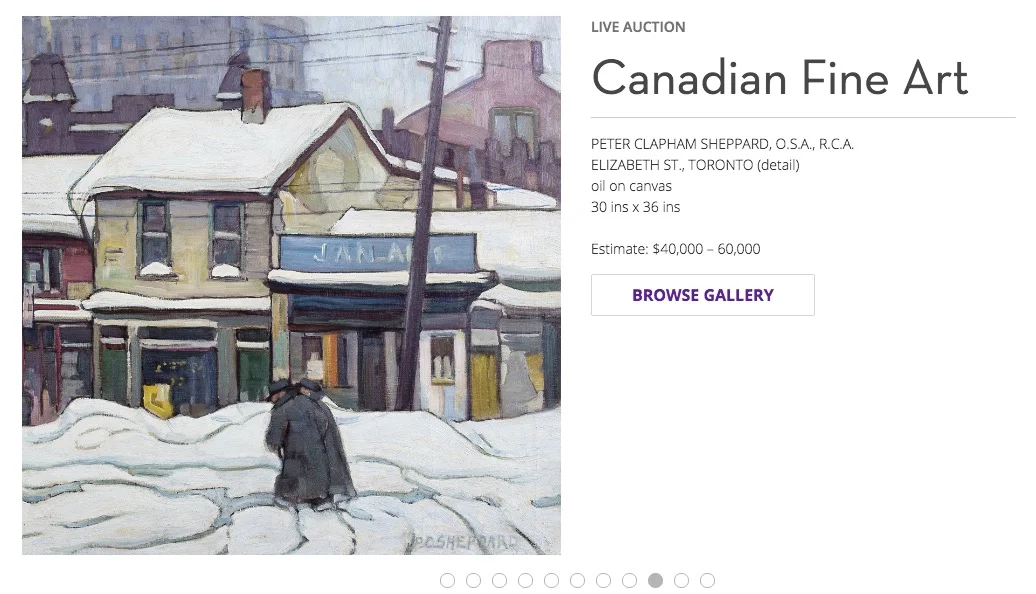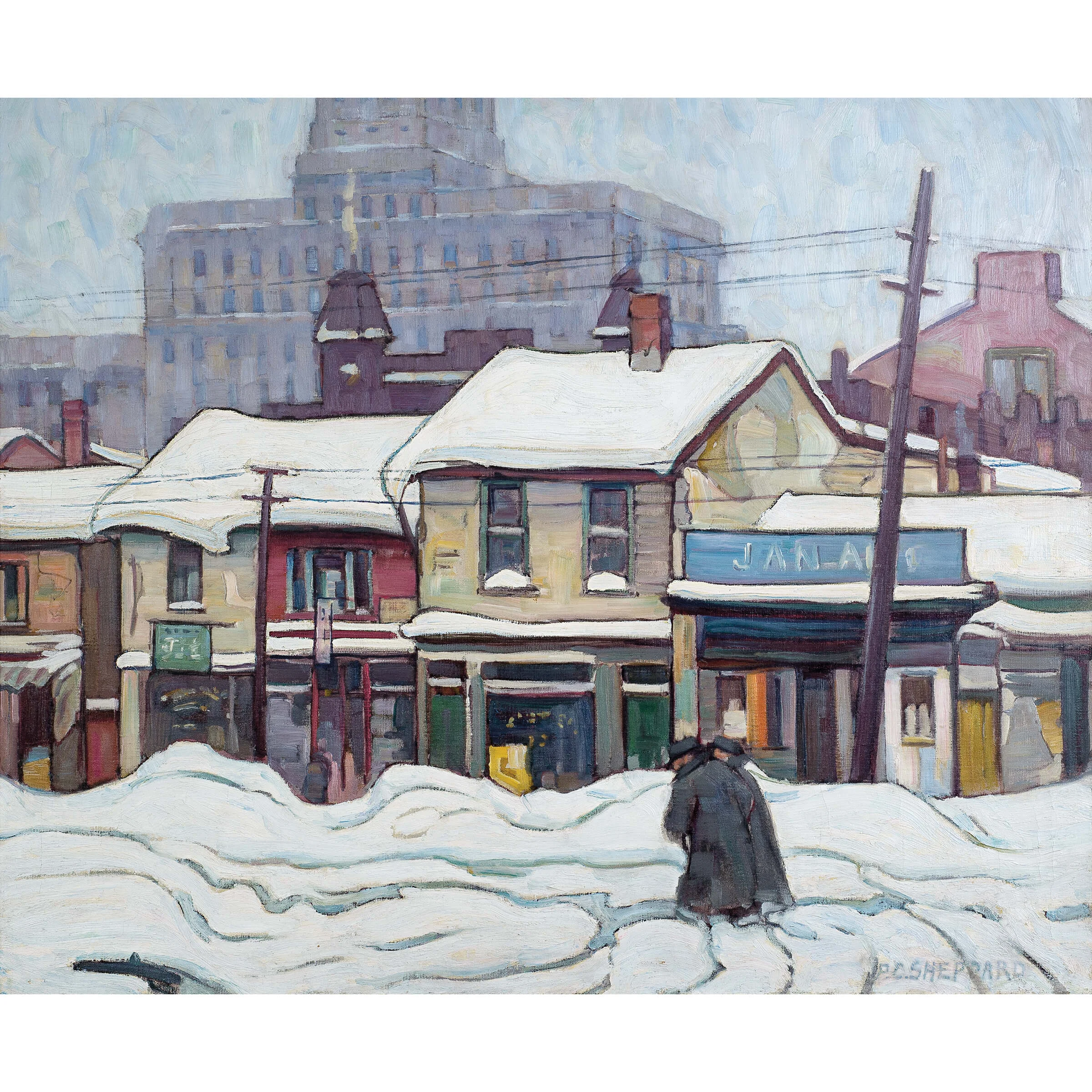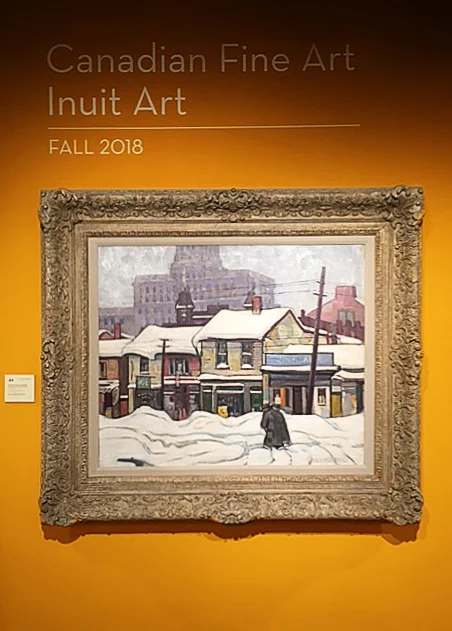News and Auctions
The Bridge Builders, Construction, Bloor Street Viaduct, 1915 by Peter Clapham Sheppard for Sale at Cowley Abbott
Lot #35
P.C. Sheppard
The Bridge Builders, Construction, Bloor Street Viaduct, 1915
oil on canvas
signed lower right; estate stamp on reverse of framing and on crossbar
58 x 40 in ( 147.3 x 101.6 cm )
Auction Estimate: $100,000.00 - $120,000.00
Provenance:
Estate of the Artist
Exhibited:
"44th Annual Exhibition", Ontario Society of Artists, Art Museum of Toronto, 11 March-15 April 1916, no. 117 as "Construction, Bloor St. Viaduct" at $300
"38th Annual Exhibition", Royal Canadian Academy of Arts, Art Association of Montreal, 16 November-16 December 1916, no. 212 as "The Bridge Builders (Bloor St. Viaduct, Toronto)"
"50th Annual Exhibition", The Ontario Society of Artists, Art Gallery of Toronto, 18 March-24 April 1922, no. 160 as "Bridge Building" at $350
"Paintings and Sculpture by British, Spanish and Canadian Artists and International Graphic Art", Canadian National Exhibition, Toronto, 26 August-9 September 1922, no. 312 as "Bridge Building" at $400
"Defiant Spirits: The Modernist Revolution of the Group of Seven", McMichael Canadian Art Collection, Kleinburg, 2 October 2010-30 January 2011
Literature:
M.L.A.F. [Fairbairn], 'Some Pictures at the Art Gallery', "The Toronto Daily Star" (11 March 1916), page 5
'Ontario Artists do Daring Work', "Mail and Empire" (11 March 1916), page 5
Estelle Kerr, 'At the Sign of the Maple', "The Courier", XIX:17 (25 March 1916), page 13
[Augustus Bridle], 'A Little Painting Now and Then', "The Courier", XXI:1 (2 December 1916), reproduced page 12 as "The Concrete Bridge"
Harold Mortimer-Lamb, 'The Thirty-Eighth Exhibition of the Royal Canadian Academy of Arts', "The Studio", LXX: 287 (February 1917), page 39
Thomas Taylor, 'The Bloor Street Viaduct, Toronto', "The Journal of the Engineering Institute of Canada", vol. 2, no. 7 (July 1919), pages 485-498
Evelyn McMann, "Royal Canadian Academy of Arts/Académie royale des arts du Canada Exhibitions and Members 1880-1979", Toronto, 1981, page 372
Rod Staples, "Owen Staples Painter of Canada's Past", Scarborough, 1998, pages 9, 57, 61
Anastasia Rodgers, 'Constructing Beauty: The Photographs Documenting the Construction of the Bloor Viaduct', "Archivaria", 54 (Fall 2002), pages 72-91
Ann Marie F. Murnagham, 'The City, the Country, and Toronto's Bloor Viaduct, 1897-1919', "Urban History Review", XLII:1 (Fall 2013), pages 41-50
Tom Smart, "Peter Clapham Sheppard: His Life and Work", Richmond Hill, 2018, pages 19, 28, 102-107, reproduced page 102, detail reproduced on cover and dust jacket as "The Bridge Builders, Construction, Bloor Street Viaduct", 1915
"Bridging the Don: Construction", City of Toronto [online publication], accessed 1 April 2025
A massive reinforced concrete structure, its upper edges still clad in wooden forms, occupies the centre of this remarkable painting. An elevator tower connects the cables carrying concrete-filled hoppers at the centre of the composition and rises to the blue sky breaking through the clouds. The blue sky in turn creates a diagonal movement to the blue shadows lower left and to the principal subject of the painting, the workers pulling cables. If the massive structure fills most of the composition, it is the workers, the “bridge builders”, who animate the scene.
The bridge being built was in fact one of the most ambitious municipal projects undertaken by the city of Toronto, the Bloor Street Viaduct that would link Bloor Street in the west to Danforth Avenue in the east. The Don Valley and River had long posed severe problems in cross-city transportation, especially after Toronto annexed Riverdale in 1884 and East Toronto, north of the Danforth, in 1908. The only bridges crossing the Don were further south between Gerrard Street and the lake and were subject to destruction by flooding. In 1904 Owen Staples, artist for the Toronto Telegram, began construction of a beautiful Arts and Crafts home near Danforth and Broadview (now 69 Hogarth Avenue) and experienced the challenges faced by workers having to cross the Don. In 1910 he drew the new bridge being built to link Wilton Avenue (now Dundas) to the east side of the river.
The proposed viaduct had been the subject of repeated debates and its construction was voted down in municipal elections in 1910 and 1912. One issue focused on the route of the connecting roads. At this time Bloor Street only ran east to Sherbourne Street and critics, opposed to the “exaggerated importance of the straight line,” argued that the viaduct should connect to Howard and Parliament streets directing traffic down to Wellesley Street to cut costs and avoid having to connect Bloor Street to Castle Frank. Finally in January 1913 the Toronto electorate approved a three-part construction: a bridge over the Don Valley from Danforth Avenue to Castle Frank Crescent, another bridge over the Rosedale Ravine, and earth fill to connect Bloor and Parliament streets. The Don section would require six concrete piers and the Rosedale section four, lettered from east to west, A through F over the Don Valley, and H through J over the Rosedale Valley Road. Construction started with Pier D, located on the west side of the Don River, the pier depicted in Peter Sheppard’s painting.
Construction began in January 1915 and advanced rapidly as seen in photographs taken that fall. Attracted by the ambition and scale of this massive project, Sheppard painted oil sketches on site as work progressed. In one sketch, reproduced by Tom Smart in his monograph on Peter Sheppard (p. 104), railway tracks occupy the foreground in front of a recently raised elevator tower, while in a later sketch (p. 106) the pier rises almost to future road level.
Construction of the viaduct was extensively documented in photographs and Sheppard undoubtedly had access to them. Smart reproduces a photograph of Pier D taken on 22 September 1915 from approximately the same angle as Sheppard’s large canvas. However, in the canvas Sheppard dramatizes the scene by elevating the north end of the pier left foreground, and enlarges what is possibly a concrete mixer at the south end below the rising smoke. This is merely glimpsed in the September photograph but more clearly seen at the foot of the hill in a photo of piers B, C, and D, taken on 21 October 1915. In the canvas the foreground workers, absent in the photographs, animate the scene and evoke the vast human effort of the viaduct’s construction.
Born in Toronto Peter Sheppard, like many of his contemporaries, began his career working for a commercial art firm and studied at the Central Ontario School of Art and Design (from 1912 the Ontario College of Art), graduating in December 1914. In March 1916 he submitted his large canvas "Construction, Bloor St. Viaduct" for exhibition with the Ontario Society of Artists. Even amidst all the journalistic fury over J.E.H. MacDonald’s "Tangled Garden" in the same exhibition, critics praised Sheppard’s ambitious canvas. In "The Mail and Empire", the writer noted the uniqueness of the subject matter. “A number of American artists have seen the dramatic power of these engineering enterprises, and Mr. Sheppard has attacked this subject from the same angle that they have treated it. He shows the men toiling at the construction work, a vital moving scene...” The same writer noted Owen Staples’ treatment of the same subject “but in a more remote and less compelling manner. His painting is a view of the valley, with signs in the distance that the work is going forward.” And Margaret Fairbairn wrote the "Toronto Daily Star", “Mr. Staples gives a distant view of construction work on the Bloor Street viaduct, while Mr. Peter C. Sheppard, under the same title, gives a near view of the enterprise that carries with it an impression of vastness and labor involved that raises it to the level of a great epic.”
Sheppard exhibited the canvas, now titled "The Bridge Builders, Construction (Bloor Street Viaduct)" with the Royal Canadian Academy of Arts in Montreal the following November. The new title changed the focus of the subject from the more abstract construction to the heroism of the workers as earlier observed by the Toronto critics. The Montreal critic and pictorialist photographer Harold Mortimer-Lamb, praised the “ambitious picture” in the pages of the London periodical "The Studio" while the editor of the "Canadian Courier", Augustus Bridle, reproduced the canvas, retitled "The Concrete Bridge", beside "Early Spring" by Sheppard’s former teacher J.W. Beatty. Extrapolating on the importance or lack of importance of Canadian subject matter in art, Bridle wrote, “In the cement picture by Mr. Shepherd (sic), there is no lack of subject. You understand at once that by no kind of brain-twisting could it be considered a picture of sheep, or of twilight, or of the morning after. It is as realistic as a photograph. And it’s considerably, though not typically, a Canadian subject. Other countries build bridges and cement structures. Also one might imagine that the Beatty picture was painted in the State of Maine. To build a national line fence in art is foolishly impossible. We must give the artist room.”
The Rosedale bridge opened for traffic on 29 October 1917 and the Don Section on 18 October 1918. The entire project was completed on 23 August 1919 and was renamed the Prince Edward Viaduct following Prince Edward’s 1919 visit to Toronto. It is more familiarly known today as the Bloor Street Viaduct and is so memorialized in this magnificent painting by Peter Sheppard.
We extend our thanks to Charles Hill, Canadian art historian, former Curator of Canadian Art at the National Gallery of Canada and author of "The Group of Seven‒Art for a Nation" (1995), for contributing the preceding essay.
Sale Date: May 28th 2025
The Beaverbrook Art Gallery has acquired an oil on canvas by P.C. Sheppard entitled
Halifax Harbour 1934-35
Halifax Harbour 1934-35
oil on canvas 85 x 95 cm.
Exhibited: Royal Canadian Academy 1935
Oontario Society of Artists 1935 (illustrated)
Also illustrated in:
Peter Clapham Sheppard: His Life and Work, Tom Smart, Firefly, 2018. p.222
Canadian Art—Its Origins and Development, William Colgate, Ryerson Press, Toronto, 1943. p.146
Gift of Louis Gagliardi
Auctions
New records set at auction December 2022
Horticultural Building, Canadian National Exhibition 1919
Peter Clapham (P.C.) Sheppard, OSA, ARCA (1879-1965), Canadian
oil on board
signed; estate stamp with inv. no. LG132 verso; titled to label verso
8.75 x 10.75 in — 22.2 x 27.3 cm
Estimate $8,000-$10,000
Realised: $33,600 CAD ($25,109 USD)
+273%
Bonsecours Market, Montreal (c. 1926)
Peter Clapham (P.C.) Sheppard, OSA, ARCA (1879-1965), Canadian
oil on board
signed
8.5 x 10.5 ins ( 21.6 x 26.7 cms)
Estimate $10,000-$15,000
Realised: $28,800 CAD ($21,447 USD)
+130%
LOT 102
Peter Clapham Sheppard
ARCA OSA 1879 - 1965 Canadian
Haying, Combermere
oil on canvas, signed and on verso signed and titled and dated 1924 on a label
28 x 36 in 71.1 x 91.4 cm
estimate: $30,000 - $50,000
preview at: Heffel Toronto – 13 Hazelton Ave
provenance
G. Blair Laing Limited, Toronto
Private Collection, Ontario
Some 70 kilometres southeast of Algonquin Provincial Park, Combermere straddles the Madawaska River. In the 1920s the river was still used for log drives, the “dreaming melody” of its waters having long since been turned into “a roaring chant of commercial conquest” (according to Maclean’s in 1922).[1] Peter Clapham Sheppard often painted the rapids and falls of Algonquin and Muskoka, as well as the autumn leaf colour of their woods. However, on a 1924 painting expedition in the area, he was struck by a different and possibly unexpected sight near Combermere: farmhands forking hay onto a horse-drawn cart—the kind of harvest scene that marked the culmination of the summer, and which epitomized pastoral life.
Harvests, haymaking, haystacks and hay carts have a long and distinguished history in painting, from illustrated calendars in medieval books of hours to an illustrious roll call of masters that includes Hieronymus Bosch, Pieter Brueghel the Elder, John Constable, Claude Monet and Vincent van Gogh. Such scenes often represented the spectacle of man working in harmony with nature through the cycle of seasons, redeeming his fallen condition through hard and honest effort.
For Sheppard, the interest lay in the rich visual qualities of the ritual. Haying, Combermere combines two of his favourite motifs. First, masculine physical labour such as he depicted in his studies of the construction of Toronto’s Bloor Street Viaduct, done a decade earlier, as well as the stevedores and longshoremen painted during his visit to New York City in 1923. Second, sway-backed beasts of burden placidly awaiting the onset of their tasks, as seen in his many paintings of cabstands in Montreal. In fact, within the same year he painted Early Snow, Montreal, a street scene of a horse-drawn cart stacked with hay in the middle of a blizzard. This latter work appeared at the British Empire Exhibition at Wembley in 1925 and again two years later at the Exposition d’art canadien at the Musée du Jeu de Paume, in Paris, offering Sheppard valuable international exposure.
In Haying, Combermere, these two motifs leave the streets and docksides to come together in a pastoral landscape. Sheppard’s real pictorial enthusiasm lies in the sweeping contours of the mown field and, especially, in the masses of hay. Thickly and energetically painted, the hay completely engulfs the cart in a golden storm of almost abstract patterning, dwarfing the labourers and even the horses, whose stolid stances anchor the painting.
Haying, Combermere is a beautiful and accomplished study in complementary colours. The warm yellows and ochres of the field contrast with the line of scrubby, spectral trees arching through the background: a series of barbed silhouettes vigorously painted in violets and mauves with licks of fiery red-orange. Sheppard chose to omit the grove of trees—seen in his on-the-spot-charcoal sketches and a pencil and watercolour study—in order to maintain and emphasize this rich contrast.
Labeled as one of the “youngsters and experimenters” at the Ontario Society of Artists exhibition in 1927,[2] Sheppard was part of the generation of painters who challenged the outworn orthodoxies of the Canadian artistic establishment to investigate more advanced and compelling idioms. Unlike some of his contemporaries, he was refreshingly versatile in his subject matter, turning his curious and easily enchanted gaze to the rich panoply of twentieth-century life—including this timeless scene of rural activity.
We thank Ross King, author of Defiant Spirits: The Modernist Revolution of the Group of Seven, for contributing the above essay.
1. Charles Christopher Jenkins, “J. R. Booth—On the Job at 95,” Maclean’s, May 15, 1922, 15.
2. “Radical Painters Showing Their Work,” Toronto Mail and Empire, March 5, 1927, quoted in Tom Smart, Peter Clapham Sheppard: His Life and Work (Richmond Hill, ON: Firefly Books, 2018), 153.
estimate: $30,000 - $50,000
All prices are in Canadian Dollars
LIVE AUCTION
Canadian, Impressionist & Modern Art
7 PM ET sale
June 23, 2021 | 7 PM
Lot # 241
The Group of Seven & their Contemporaries Online auction
Peter Clapham Sheppard
ARCA OSA 1879 - 1965 Canadian
Portrait of a Man in a Rowboat (Possible Portrait of Tom Thomson)
oil on board circa 1910 ~ 1912
signed and on verso signed
9 1/2 x 6 in 24.1 x 15.2cm
Provenance:
Private Collection, Toronto
Literature:
Tom Smart, Peter Clapham Sheppard: His Life and Work, 2018, reproduced page 74
This portrait is believed to be of Canadian icon Tom Thomson. Thomson and Sheppard were contemporaries in Toronto’s cultural milieu of the early 1900s. They shared many common points of contact including J.W. Beatty, William Cruikshank and the Ontario Society of Artists. Thomson and Sheppard were even briefly neighbours on Summerhill Avenue in 1912. The two developing artists shared many of the same aesthetic sympathies, as modernism and a new approach to painting began to take root in Canada. They would likely have had numerous opportunities to cross paths and possibly even paint together.
The artist Bernice Fenwick-Martin, a friend and peer of Sheppard, and the manager of his Estate, relayed to the consignor of this work that Sheppard expressed that this portrait was indeed of his friend and neighbour on Summerhill, Tom Thomson.
The circa date ascribed to this painting relates to the period in which Sheppard is known to have used this panel size, which is believed to be a cigar-box lid. The additional images demonstrate the resemblance of Thomson to the subject of the painting, in both physical appearance and dress.
As so few depictions of Thomson exist, this work presents a potentially invaluable addition to Canadian art history.
Estimate:
$6,000 ~ $8,000 CAD
Lot # 117
Canadian, Impressionist & Modern Art Live auction
Peter Clapham Sheppard
ARCA OSA 1879 - 1965 Canadian
Cabstand, Montreal
oil on canvas 1927
signed and on verso stamped with the estate stamp #LG222
24 x 30 in 61 x 76.2cm
Provenance:
Private Collection, Toronto
Literature:
Tom Smart, Peter Clapham Sheppard: His Life and Work, 2018, reproduced page 157
“Peter Clapham Sheppard: A Canadian Master Rediscovered,” https://www.pcsheppard.com/major-canvases/iwkdf758wl2vjksf0i1lrifjdou9ut, reproduced, accessed February 22, 2018
Louis Gagliardi, "On Peter Clapham Sheppard," https://www.pcsheppard.com/pcsheppard, accessed February 22, 2018
Born in Toronto in 1879, Peter Clapham Sheppard produced a wide-ranging body of work that included classical figure drawings, post-Impressionist landscapes and vivid, modernist cityscapes of Toronto, New York and Montreal. He was able to synthesize into his own expression the leading influences of his day - such as the Hague School of the Netherlands, Scandinavian winter landscapes and the Ashcan School of New York - creating a unique and expressive style at a time when prevailing tastes in Canada were decidedly classical. Though every bit the calibre of most lauded painters of the period, for many years Sheppard’s work has fallen victim to an obscurity stemming from the sometimes limiting tendency to think of art history as populated by a series of succeeding movements rather than by individuals. This approach is understandable as it provides an overarching and easily grasped narrative by which to assign importance and value, but it can limit an engagement with the life work of many artists that a more nuanced approach enables.
Though never a part of any particular group, Sheppard belonged to a generation that sought new styles of painting in Canada, and like many, he studied under George Reid and J.W. Beatty at the Ontario College of Art. He painted shoulder to shoulder with the most beloved artists in Canadian art history, but unlike many artists of that period, he held an equal affinity for both rural and urban imagery, which is clearly evidenced by Cabstand, Montreal from 1927.
Typical of Sheppard’s distinctive approach, strongly outlined forms and a heightened palette add a modern sense to the composition. The foreground forms also provide effective contrast against the screen of Barbizon-style trees and the misty rendering of the city beyond. Preparatory sketches for this work, an ink wash drawing and a watercolour, executed on the spot, are shown here, and capture a casual intimacy. The conversing figures and the patiently waiting horses contribute warmly to the sense of a captured moment of what is now a part of Montreal’s treasured past. Textural brushwork lends a sense of authenticity to the scene, such as in the ruts in the snow made by the runners of many previous sleighing excursions. The sleighs themselves, romantic and inviting, welcome the viewer in from the winter chill the artist so convincingly evokes. The overall tone of the work possesses a strength and solidity that is so uniquely Canadian. In Cabstand, Montreal, Sheppard has created a painting that is at once a strong personal expression and a historical document, and it is an exceptional example from a body of work ripe for rediscovery.
Estimate:$70,000 ~ $90,000 CAD Sold for:$157,250 CAD (including Buyer's Premium)
Preview at: Design Exchange Toronto
Currency converter
All prices are in Canadian Dollars.
Elizabeth Street, Toronto
Waddington’s Canadian Fine Art Auction
PETER CLAPHAM SHEPPARD, O.S.A., R.C.A.
ELIZABETH STREET, TORONTO
oil on canvas
signed; with the estate stamp on the reverse
30 ins x 36 ins; 73.7 cms x 88.9 cms
Estimate $40,000-$60,000
Realised: $204,000
About artist/note:
Remarkably, it is only quite recently that the work of Peter Clapham Sheppard (1882-1965) has attracted significant interest of a broader group of serious collectors of important Canadian Art. The reason for this is typically ascribed to the massive shadow cast by his contemporaries, the Group of Seven, who for decades were considered Canada’s greatest fine art innovators, founders of our nationalist school of painting. However, that notion was being challenged even as it was being formulated. When F.B. Housser’s book A Canadian Art Movement was published in 1926, artist W.J. Phillips responded by explaining: “(The Group of Seven) have had a great deal of advertisement, but it generally has been at the expense of other painters.” … “Those of the Seven that I know intimately do not regard their works as the absolute perfection…The comparatives, exaggerated eulogisms, and drastic condemnations (of other art) comes from the less enlightened layman who considers himself a critic”. Nonetheless, the unintended, decades-long consequence of the mythologizing of the Group was that other talented Canadian artists in Ontario and beyond were overshadowed, leaving a dramatic gap in the scholarship.
More recently the space taken up by the Group has ceded some territory to new scholarship whose aim it is to examine those artists – those working outside the major city centres, women artists and First Nations art makers - who were perhaps within the Group’s orbit but who had essentially been relegated to the B team. P.C. Sheppard is now the subject of a major monograph by respected writer, curator and art historian, Tom Smart, whose book on Sheppard was released this fall. Smart argues that artists such as Sheppard “through no fault of their own, and not through the quality of their art, drifted from public consciousness and were forgotten.” Smart’s new publication is an attempt to redress this.
The group of Toronto Ward paintings produced by Sheppard, of which this lot is one of his finest, were executed at the beginning of the 1930s. Sheppard had painted the cities of Montreal and New York a few years earlier. Upon returning to Toronto, he turned his eye to a relatively poor neighbourhood rich in subject matter that had also attracted Lawren Harris who himself had immortalized the subject. Like Harris, Sheppard sought to capture the Ward's “gritty working class streets (particularly Louisa and Elizabeth Streets), alleys, houses and shacks as portraits of resilient survival in places defined by transition and impoverishment.”
Smart notes that Sheppard’s composition of Elizabeth Street: "juxtaposes the domestic and commercial nature of the subject... the row of hardscrabble houses and businesses cobbled together, weighted down by the heavy burden of snowfall as well as by the looming towers of the commercial district beyond.” In the distance, Sheppard incorporates a newly minted skyline featuring the “looming” outline of the fifteen storey, beaux-arts style beauty, the Canada Life Building, whose construction started in 1929 and was completed in 1931.
Smart notes that the composition of Elizabeth Street uses a device that Sheppard established while painting in New York. “The composition divides the format horizontally in two ranks: above the divide is an anonymous cityscape of towering commercial buildings and skyscrapers, while below is the urban hurly-burly of boisterous activity, horse and carriage traffic and pedestrians.” Smart further notes that “contrasts abound in the painting between the natural and the built: the human-scaled houses and the gargantuan commercial buildings; snow and stone; geometric and lyrical lines.” Smart also maintains that it is large format paintings, such as this lot, “that give wider fields for Sheppard to display his talent and imagination as he interpreted the rapid industrial and social growth” of cities like Toronto. The result is that Elizabeth Street is a tour de force of expression, making great use of an array of colour (mauve, violet, plum, alabaster, almond, oyster, ruby, crimson, scarlett, canary, amber, teal) and brushstroke.
Copies of Tom Smart’s new publication, “Peter Clapham Sheppard: His Life and Work”, are available for purchase from Waddington’s during our auction preview and sale.
Literature:
Charles C. Hill, The Group of Seven: Art for a Nation, National Gallery of Canada, Ottawa, 1995, page 169.
Tom Smart, Peter Clapham Sheppard: His Life and Work, Firefly Books, Richmond Hill 2018, pages 25, 28, 135, 208, page 189, for a detail of this lot, reproduced in colour, as the frontispiece for Chapter 5: Toronto, page 214 for the closely related watercolour of Elizabeth Street, 1930-31 on which this canvas is based, reproduced in colour, page 217 for a discussion of this work, and page 220, for this lot reproduced in colour.
Provenance:
Estate of the artist
Private Collection, Toronto
Exhibited:
61st Annual OSA Exhibition, Ontario Society of Artists, Art Gallery of Toronto, 1933.
Additional Info:
Department: Canadian Fine Art
Medium: Paintings
Signed
Auction Preview, Waddington’s November 2018
CanadianArt Magazine Presents
NEWS / NOVEMBER 22, 2018
Records Broken at Canada’s Fall Auctions
Heffel, Waddington's and Consignor all held their major fall auctions this week. Here are some of the highlights
Kenojuak Ashevak's Enchanted Owl broke the Canadian print auction record at a Waddington's auction this week. Image: Courtesy Waddington's.
by Leah Sandals
Several records were broken at Canada’s big fall art auctions this week in Toronto. Some of the records were for novelty or rarity paintings, some were for rising market names, and others were for iconic Canadian artists. Overall, says Waddington’s VP Stephen Ranger of what he observed at his house’s two auctions, “the results point to a continued resiliency of the Canadian art market…. Despite the fact that the stock markets took a beating this week, we had a full room, with very active and assertive bidding.”
…
This fall season has also seen the rise, in and out of auction, of the profile of Peter Clapham Sheppard. This Group of Seven–adjacent artist created mainly urban-focused paintings that until recently have been somewhat overlooked. That is changing with the publication of a book, Peter Clapham Sheppard, authored by Beaverbrook Art Gallery director Tom Smart and supported by Sheppard collector Louis Gagliardi.
A world auction record for a painting by Peter Clapham Sheppard was set at the Waddington’s Canadian Art Auction on November 19. It was for his painting Elizabeth Street of the early 1930s, which depicts a downtown Toronto scene. The painting went for $204,000 hammer price, at least four times its initial estimate of $40,000 to $60,000.
That initial Sheppard estimate was “one-twentieth of what would be assigned to a comparably sized [Lawren] Harris canvas of the Ward [neighbourhood in Toronto],” art historian Gregory Humeniuk wrote in theGlobe and Mail in advance of Elizabeth Street’s auction. He added: “In today’s art market, a truly significant work by him plays well to the rule of thumb that it’s better to buy an A work by a B artist, than to buy a B work by an A artist.”
Peter Clapham Sheppard's 1930s painting Elizabeth Street set a new record for the artist at the Waddington's auction. Image: Courtesy Waddington's.
…
Leah Sandals
Leah Sandals is news and special sections editor at Canadian Art. A graduate of NSCAD University and McGill University, she has also written for the Toronto Star, National Post and Globe and Mail. She welcomes tips, corrections and comments any time at leah@canadianart.ca.
The Boardwalk, Atlantic City, New Jersey
Consignor Canadian Fine Art
oil on canvas
signed lower right; estate stamp (LG1919) on the stretcher; dated circa 1919 on an estate label on the reverse of the framing
21.25 x 17 ins ( 54 x 43.2 cms )
Estimated: $9,000.00 - $12,000.00
Provenance:
Estate of the artist
Private Collection, Ontario
Literature:
Tom Smart, Peter Clapham Sheppard: His Life and Work, Richmond Hill, Ontario, 2018, reproduced page 137
A Toronto native, Peter Clapham Sheppard occupies a place in Canadian art history among a generation of artists that established a distinctively Canadian school of art. While the painter studied, sketched and exhibited alongside members of the Group of Seven, Sheppard found inspiration in more broad subject matter, including landscapes, portraits, still lifes, city and harbour scenes. Sheppard bore witness to the steady construction and urbanization that took place in Canadian and American cities during the first half of the twentieth century, which inspired much of his artistic oeuvre. In this regard, Sheppard saw himself as better aligned with the contemporaneous American society of artists known as the Eight, and later the Ashcan School. Members of these groups depicted the bustling streets of New York City in a colourful, expressive and anti-academic manner. Sheppard exemplifies this approach in many of his urban scenes of the early 1920s, including paintings of Toronto, Montreal, New York City, and in this instance, Atlantic City. The vibrant canvas “The Boardwalk, Atlantic City” (1922) embodies these anti-aesthetic intentions in its decorative colour palette and contemporary reflection of middle-class urban life. Author and art historian Tom Smart writes in his recent book on Sheppard that “[i]n artistic terms, Sheppard identified with human subjects in gritty urban settings.” Smart elaborates further on Sheppard’s talent in painting city scenes, remarking that he “captured an essential liveliness, apparently easily, gesture and rhythms of line and colour simulate as if by magic the cacophony and harmonies of his subjects.”
P.C. Sheppard was captivated by subjects involving a human presence, particularly crowds in city streets, markets, county fairs, circuses and harbour scenes. In many of these artworks, the artist illustrates the stark contrast between humans and the sublime landscape or the power of industrialization. Tom Smart comments on this theme present in “The Boardwalk, Atlantic City” and similar works of the early 1920s, remarking that Sheppard “explores the dichotomy between human-scaled objects and the almighty dehumanization of the modern city.” The author points out the “two-ranked composition in the boardwalk” of this vibrant canvas, and describes it as “a painting that recalls the ambitions of arrival of the circus with its heavily populated foreground overshadowed by an elevated avenue separating the maelstrom from the built structures looming over everything.”
A copy of “Peter Clapham Sheppard: His Life and Work”, the 2018 book devoted to the artist and within which this artwork is reproduced, is included with this lot.
Sale Date: November 20th 2018

